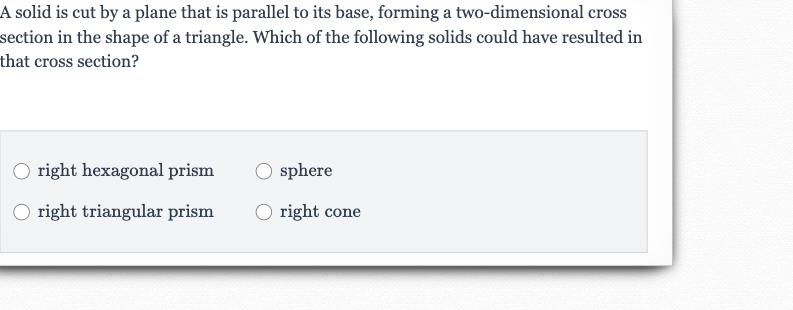AI tutor
Welcome to Bytelearn!
Let’s check out your problem:

A solid is cut by a plane that is parallel to its base, forming a two-dimensional cross section in the shape of a triangle. Which of the following solids could have resulted in that cross section?right hexagonal prismsphereright triangular prismright cone
Full solution
Q. A solid is cut by a plane that is parallel to its base, forming a two-dimensional cross section in the shape of a triangle. Which of the following solids could have resulted in that cross section?right hexagonal prismsphereright triangular prismright cone
- Consider Solid Shapes: Let's consider each solid and determine if a plane cut parallel to its base could result in a triangular cross section.
- Hexagonal Prism: First, we look at the right hexagonal prism. A hexagonal prism has a hexagon for its base. If we cut it with a plane parallel to its base, the cross section would also be a hexagon, not a triangle.
- Sphere: Next, we consider the sphere. A sphere does not have a base in the same way a prism does, and any cross section through a sphere is a circle. Therefore, it cannot have a triangular cross section.
- Triangular Prism: Now, let's examine the right triangular prism. A triangular prism has a triangle for its base. If we cut it with a plane parallel to its base, the cross section would be the same shape as the base, which is a triangle.
- Cone: Finally, we look at the right cone. A cone has a circular base, and a plane cut parallel to its base would result in a circular cross section, not a triangular one.
More problems from Scale drawings: word problems
QuestionGet tutor help
QuestionGet tutor help
QuestionGet tutor help
QuestionGet tutor help
QuestionGet tutor help
QuestionGet tutor help
QuestionGet tutor help
QuestionGet tutor help
QuestionGet tutor help
